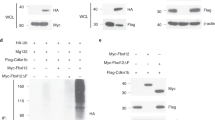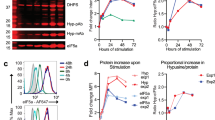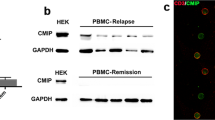Abstract
CELLS need to distinguish between transient Ca2+ signals that induce events such as muscle contraction, secretion, adhesion and synaptic transmission, and sustained Ca2+ signals that are involved in cell proliferation and differentiation. The latter class of events is blocked in lymphocytes by the immunosuppressive drugs cyclosporin A and FK506, which inhibit calcineurin, a Ca2+-activated serine/threonine phosphatase necessary for the nuclear import of NF-AT transcription factors1–4. Here we report that sustained high concentrations of Ca2+, but not transient pulses, are required to maintain NF-AT transcription factors in the nucleus, where they participate in Ca2+-dependent induction of genes required for lymphocyte activation and proliferation. Furthermore, overexpression and constitutive nuclear localization of NF-AT, but not Jun, Fos, NF-κB, Oct or Ets family members, renders the interleukin-2 enhancer in Jurkat T lymphocytes resistant to FK506 and cyclosporin A. Thus a primary effect of these immunosuppressive reagents is to control the subcellular localization of the NF-AT family of transcription factors.
This is a preview of subscription content, access via your institution
Access options
Subscribe to this journal
Receive 51 print issues and online access
$199.00 per year
only $3.90 per issue
Buy this article
- Purchase on Springer Link
- Instant access to full article PDF
Prices may be subject to local taxes which are calculated during checkout
Similar content being viewed by others
References
Klee, C. B., Crouch, T. H. & Krinks, M. H. Proc. Natl Acad. Sci. USA 76, 6270–6273 (1979).
Liu, J. et al. Cell 66, 807–815 (1991).
Clipstone, N. A. & Crabtree, G. R. Nature 357, 695–697 (1992).
Flanagan, W. F., Cothesy, B., Bram, R. J. & Crabtree, G. R. Nature 352, 803–807 (1991).
Nowell, P. C. Cancer Res. 20, 462–466 (1960).
Whitney, R. B. & Sutherland, R. M. J. Cell Physiol. 80, 329–337 (1972).
Tsien, R. Y., Rozzan, T. & Rink, T. Nature 295, 68–71 (1982).
Weiss, A., Shields, R., Newton, M., Manger, B. & Imboden, J. J. Immunol. 138, 2169–2176 (1987).
Shaw, K. T.-Y. et al. Proc. Natl Acad. Sci. USA 92, 11205–11209 (1995).
Rao, A. Immunol. Today 15, 274–281 (1994).
Crabtree, G. R. & Clipstone, N. A. Annu. Rev. Biochem. 63, 1045–1083 (1994).
Hodge, M. R. et al. Immunity 4, 397–405 (1996).
Northrop, J. P. et al. Nature 369, 497–502 (1994).
Ho, S. N. et al. J. Biol. Chem. 270, 19898–19900 (1995).
Hoey, T., Sun, Y.-L., Williamson, K. & Xu, X. Immunity 2, 461–472 (1995).
Masuda, E. S., Naito, Y., Tokumitsu, H. et al. Mol. Cell Biol. 15, 2697–2706 (1995).
Serafini, A. T., Lewis, R. S., Clipstone, N. A. et al. Immunity 3, 239–250 (1995).
Fanger, C. M., Hoth, M., Crabtree, G. R. & Lewis, R. S. J. Cell Biol. 131, 655–667 (1995).
Jain, J., Miner, Z. & Rao, A. J. Immunol. 151, 837–848 (1993).
Ho, S. N., Biggar, S. R., Spencer, D. M., Schreiber, S. L. & Crabtree, G. R. Nature 382, 822–826 (1996).
Emmel, E. A. et al. Science 246, 1617–1620 (1989).
Su, B. et al. Cell 77, 727–736 (1994).
Turner, C. A. Jr, Mack, D. H. & Davis, M. M. Cell 77, 297–306 (1994).
McKnight, S. L. & Yamamoto, K. R. Transcriptional Regulation Vols I and II (Cold Spring Harbor Laboratory Press, New York, 1992).
Weintraub, H. et al. Science 251, 761–766 (1991).
Courtois, G., Morgan, J. G., Campbell, L. A., Fourel, G. & Crabtree, G. R. Science 238, 688–692 (1987).
Ho, A. M., Jain, J., Rao, A. & Hogan, P. G. J. Biol. Chem. 269, 28181–28186 (1994).
Sander, B., Hoiden, I., Andersson, U., Moller, E. & Abrams, J. S. J. Immunol. Meth. 166, 201–214 (1993).
Melton, D. A. et al. Nucleic Acids Res. 12, 7035–7056 (1984).
Fiering, S. et al. Genes Dev. 4, 1823–1834 (1990).
Author information
Authors and Affiliations
Rights and permissions
About this article
Cite this article
Timmerman, L., Clipstone, N., Ho, S. et al. Rapid shuttling of NF-AT in discrimination of Ca2+ signals and immunosuppression. Nature 383, 837–840 (1996). https://doi.org/10.1038/383837a0
Received:
Accepted:
Issue Date:
DOI: https://doi.org/10.1038/383837a0
This article is cited by
-
Interplay Between Inflammatory-immune and Interleukin-17 Signalings Plays a Cardinal Role on Liver Ischemia-reperfusion Injury—Synergic Effect of IL-17Ab, Tacrolimus and ADMSCs on Rescuing the Liver Damage
Stem Cell Reviews and Reports (2023)
-
Inhibition of PPARα target genes during cyclosporine A-induced nephrotoxicity and hepatotoxicity
Molecular & Cellular Toxicology (2019)
-
Recent advances in cyclosporine drug delivery: challenges and opportunities
Drug Delivery and Translational Research (2019)
-
Nuclear calcineurin is a sensor for detecting Ca2+ release from the nuclear envelope via IP3R
Journal of Molecular Medicine (2018)
-
miR-146a facilitates osteoarthritis by regulating cartilage homeostasis via targeting Camk2d and Ppp3r2
Cell Death & Disease (2017)
Comments
By submitting a comment you agree to abide by our Terms and Community Guidelines. If you find something abusive or that does not comply with our terms or guidelines please flag it as inappropriate.



